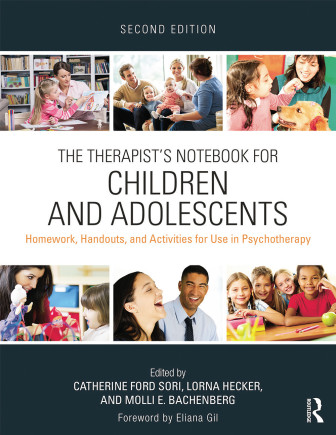 Catherine Ford Sori, professor of psychology and counseling at Governors State University, has joined forces with Lorna L. Hecker, faculty in the marriage and family therapy program in the department of behavioral sciences at Purdue University, and Molli E. Bachenberg, assistant professor at Florida Gulf Coast University, to generate the second edition of “The Therapist’s Notebook for Children and Adolescents.”
Catherine Ford Sori, professor of psychology and counseling at Governors State University, has joined forces with Lorna L. Hecker, faculty in the marriage and family therapy program in the department of behavioral sciences at Purdue University, and Molli E. Bachenberg, assistant professor at Florida Gulf Coast University, to generate the second edition of “The Therapist’s Notebook for Children and Adolescents.”
This book is a compendium of useful tools to support children and teens in expressing their feelings. It also offers suggestions for group therapy, play therapy and initiating parental involvement in therapy. This information is not just geared toward the clinical professional but is also useful for the youth worker and facilitator designing youth programs, with clear, practical scenarios that may be encountered with troubled youth and solutions on how to deal with such instances.
This new second edition, offering more than 60 percent new material, is divided into 10 clear sections, with multiple chapters within each. The chapters are organized in a user-friendly, easy-to-read style, with instructions for activities, illustrations and case study examples.
The first section deals with the role of play in child and family therapy. “Occasionally, parents are uncertain about the relevance and efficacy of play in therapy sessions, believing children play merely for entertainment,” writes Linda Wark in the opening chapter. “One challenge for therapists who use play in therapy can be to convince parents that play can help achieve resolution of serious concerns.”
Wark, an associate professor in the department of human services at Purdue University, discusses the special situation of children who may have difficulty engaging in play behavior due to abuse. She offers suggestions for youth workers navigating situations such as these and ways to help youth communicate verbally or through play.
In the same section, Paula Franklin, MA, LCPC, offers a chapter on using objects as metaphors, and Catherine Ford Sari explains the role of puppets in therapeutic assessment. Jenifer D. Lucas, Lucas Darragh, Paulette Foster and Natsa Brozovic compose a chapter on creating a “Family Video Game,” and Liana Lowenstein closes out the section on play with a chapter on creating a “Family Card Game,” a question-and-answer method for increasing family communication.
Successive sections focus on working with children’s emotions, strengthening attachment bonds and overcoming specific childhood problems such as bullying, mood and behavioral disorders. Of particular interest is the chapter co-authored by Catherine Ford Sari and Nancee Biank that explores the use of relaxation, visualization and music with children who display signs of anxiety or hyperactivity. “Severe anxiety,” write Sari and Biank, “can negatively impact children’s school performance and social relationships, and when children become so anxious or fearful that their well-being is affected the problem needs to be addressed.” While anxiety is often hereditary, relaxation techniques such as paying “attention to their breathing” and “visual imagery in combination with music” were useful for children and adolescents.
“Pie Scapes: Exploring Children’s Thoughts and Feelings,” another chapter by these same co-authors, focuses on a simple technique to help children “limited by their verbal skills and cognitive development in being able to express their thoughts and feelings, especially following a traumatic or life-altering event.”
Two additional sections that are of specific interest to youth workers are Section 6, focusing on the influence of culture on adolescents, and Section 9, which focuses on youth issues that specifically arise in schools and other group settings.
The last few sections of the book are devoted to problems arising from trauma and suicidal ideation, illness and bereavement, divorce and sexuality. The editors make a special note to discuss tools for youth workers to assess emotional and/or behavioral problems and troubleshoot accordingly.
“The Therapist’s Notebook” is a straightforward, instructive book put together by a talented editorial team. It is a useful guide for the clinician and youth worker in any setting who needs to assist youth with behavioral or emotional problems as well as youth who need help communicating safely and effectively. Through detailed chapters written by experts in the field which target specific issues, the editors offer helpful guidelines and successful case studies. And, with its specific focus on parental involvement,
“The Therapist’s Notebook” proffers an abundance of information not just for youth professionals working in the field but also for parents at home.
Further Reading:
“Treating Anxious Children and Adolescents: An Evidence-Based Approach,” Ronald Rapee, Ann Wignall, J. Jennifer Hudson and Carolyn Schniering, New Harbinger Press, 2000 Case studies and analysis in treatment of children and adolescents experiencing anxiety.
“Growing Up With Divorce: Helping Your Child Avoid Immediate and Later Emotional Problems,” by Neil Kalter, Free Press, 2005 A guide to helping children navigate parental divorce in an emotionally healthy manner.




























